Lilacs are native to Eastern Europe and parts of Asia, where they were cultivated for their delicate flowers and sweet fragrance. Symbolically, they’re associated with love and renewal.
These bushes can be grown in various environments, making them popular for hedges and landscaping worldwide. They’ve been present in Southern California landscapes since the 19th century, when settlers introduced them to the region.
Why Grow Lilacs?
Lilacs come with plenty of advantages, such as:
- Fragrance: Lilacs emit one of the most iconic floral scents.
- Low Maintenance: Once established, lilac bushes require minimal care.
- Attracting Pollinators: Lilacs draw bees, butterflies, and hummingbirds, helping support your local ecosystem.
- Versatility: They can be planted as a single feature shrub or used as hedging, providing privacy and natural fencing.
- Longevity: With proper care, lilac bushes can thrive for decades.
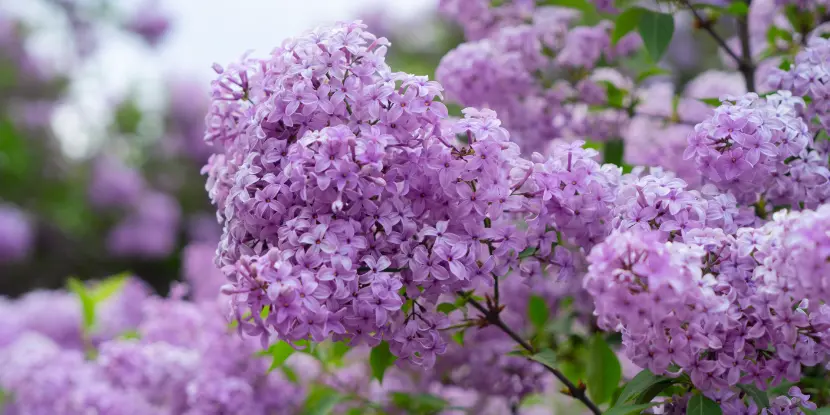
Clusters of flowers on a lilac shrub.
Choosing Your Lilac Vary
The following lilac varieties are particularly well-suited for Southern California’s warm and arid conditions:
- Blue Skies Lilac (Syringa vulgaris’ Blue Skies’) tolerates warmer climates and produces stunning light lavender-blue flowers.
- Lavender Lady (Syringa vulgaris’ Lavender Lady’) is bred for milder climates and is a top choice for Southern California. It blooms abundantly even without extended cold periods.
- Angel White Lilac (Syringa vulgaris’ Angel White’) has elegant, pure white blossoms and adapts well to the moderate winters of Southern California.
- Excel Lilac (Syringa x hyacinthiflora ‘Excel’) is a hybrid option that blooms early and easily withstands warmer temperatures.
Ideal Growing Conditions
Temperature
- Lilac bushes grow best in regions with cold winters (USDA Zones 3–7).
- They require a period of chilling dormancy to produce blooms.
- For traditional varieties, temperatures between 32°F and 45°F (0°C to 7°C) during dormancy are ideal to encourage blooming.
- For warmer climates, select heat-tolerant varieties like those listed above, which can thrive in temperatures reaching up to 85°F (29°C) during the growing season.
- Avoid extreme heat and humidity, which can stress lilac bushes and reduce flowering.
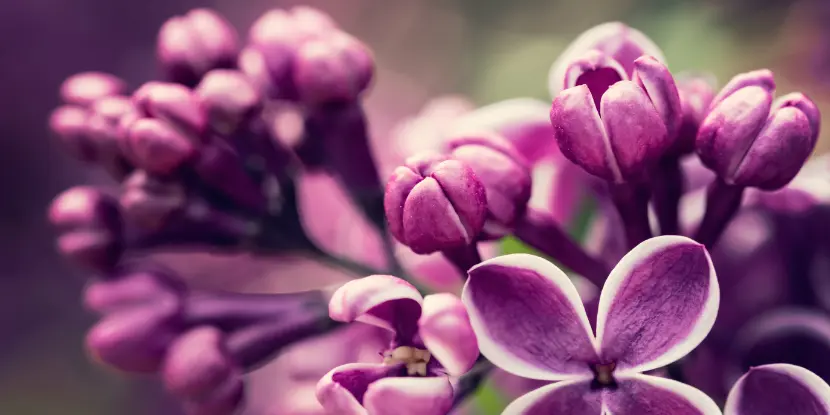
Lilac buds beginning to open.
Light
- Lilacs need at least 6 hours of full sunlight daily.
- Insufficient light can result in fewer blooms and leggy growth.
- Afternoon shade in hot climates can reduce wilting and sunburn.
Soil
- Lilacs prefer loamy, well-drained soil with a neutral to slightly alkaline pH (6.5–7).
- Adding organic matter like compost or aged manure can improve soil quality and drainage.
- Avoid acidic or heavy clay soils, which can cause root rot and inhibit growth.
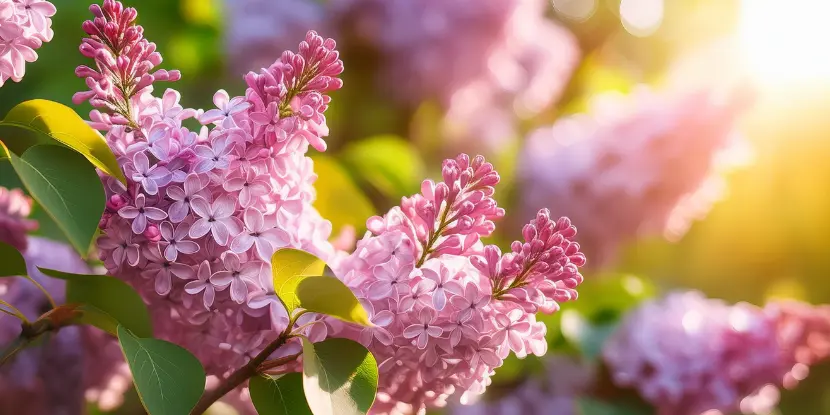
Pink lilac flowers in full bloom.
Propagating Lilacs
Lilacs can be grown from seeds, cuttings, or suckers. For best results:
- Suckers (new shoots growing from the root system) are the easiest way to propagate lilacs. Dig up a sucker with roots and replant it.
- Cuttings can be taken from healthy branches in late spring or early summer. Use rooting hormone to promote growth.
- Seeds should be planted in the fall, as they require a period of chilling to germinate.
- Allow your lilac bushes to mature for at least 3 years before attempting propagation.
How to Plant Lilac Bushes
Early spring or fall is ideal for planting.
- Pick a sunny location with good drainage.
- Dig a hole twice as wide and deep as the root ball.
- Enrich the soil with compost to boost nutrients.
- Place the bush in the hole so the crown sits level with the soil. Fill in and lightly tamp the soil.
- Thoroughly water after planting to help settle the soil.
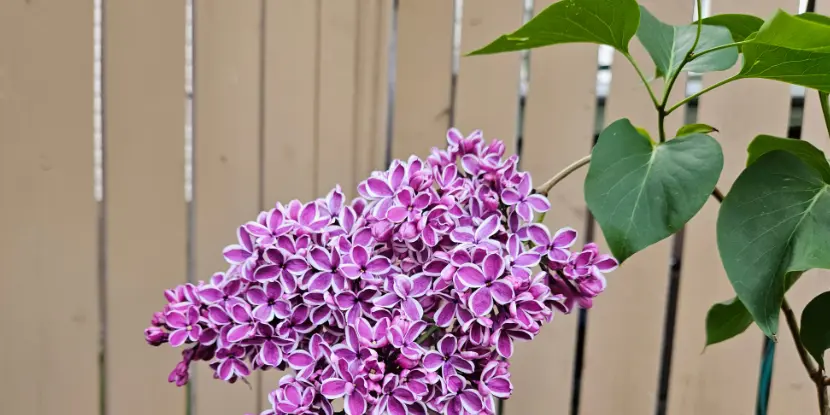
Lilac blossoms on a young plant.
Care & Maintenance for Lilacs
Once established, lilacs are relatively easy to care for. With these simple maintenance practices, they’ll reward you with stunning blooms and intoxicating fragrances.
Water
- New plants should be watered deeply every 7–10 days until roots are established.
- Established lilacs only need watering during prolonged dry periods.
- Overwatering can lead to root rot, so check soil moisture before watering.
Fertilizer
- An annual fertilizer application in early spring can promote healthier growth and blooms.
- Use a balanced, slow-release fertilizer to avoid overfeeding and burning the roots.
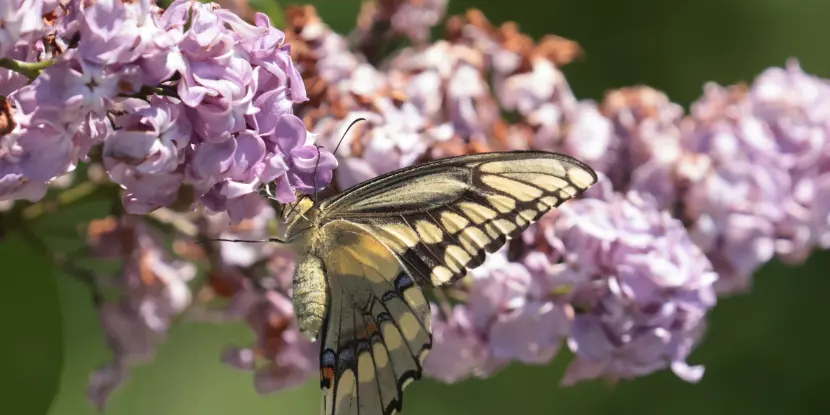
Butterflies will thank you for your lilac hedges.
Combatting Pests & Disease
Lilacs are tough plants but can suffer from pests and diseases like:
- Powdery Mildew: Prevent by ensuring proper air circulation and watering at the base of plants.
- Borers or Scale: Remove infested branches or use horticultural oil.
- Lilac Leaf Miner: Handpick affected leaves or use insecticidal soap.
Pruning Lilacs
Proper pruning maintains your lilac bushes’ health, shape, and blooming potential.
- Prune immediately after blooming in late spring or early summer to avoid cutting off next year’s flower buds.
- Remove spent blossoms to encourage growth and prevent the formation of seed pods, which can divert energy from blooming.
- Remove one-third of the oldest branches at ground level each year for three consecutive years for older, overgrown bushes.
- Thin out branches to improve airflow and sunlight penetration, especially in the shrub’s center.
- Use clean, sharp pruning shears to minimize damage and reduce the risk of disease transmission.

Lilac bushes pruned into trees.
Growing Lilacs in Containers
If you’re short on garden space, don’t worry. Lilacs can thrive as container plants.
- Choose a pot with at least 20 gallons capacity and good drainage.
- Use a high-quality potting mix with some added compost.
- Potted lilacs tend to dry out faster and may need more frequent watering.
- Move containers to a sheltered spot during winter, or wrap them to protect roots from freezing temperatures.
Common Problems & Their Solutions
Poor Blooming
- Ensure your plant receives at least 6 hours of direct sunlight daily.
- Pruning too late can remove the following year’s flower buds. Always prune immediately after blooming.
- Over-fertilizing, especially with high-nitrogen fertilizers, can promote leafy growth at the expense of flowers. Use a balanced fertilizer instead.
Yellowing Leaves
- Yellowing leaves may indicate improper watering or poor soil drainage.
- Check for root rot and improve soil drainage if necessary.
Managing Heat Stress
- Provide afternoon shade or use mulch around the root zone to retain soil moisture.
- Water deeply but infrequently during hot periods to help your plant stay hydrated.
FAQs: Growing Lilacs
Q: Do lilacs bloom in the first year after planting?
Typically, lilacs take a couple of years to establish before producing blooms. Younger plants or cuttings may take longer to flower.
Q: How tall do lilac bushes grow?
Depending on the variety, lilac bushes can grow from 4 to 15 feet high, while tree lilacs can reach up to 30 feet.
Q: Do I need more than one lilac bush for blooms?
Most lilac varieties are self-fertile, meaning a single bush can produce blooms. However, having multiple bushes can enhance cross-pollination and bloom production.
Q: Why isn’t my lilac blooming?
Common reasons include insufficient sunlight, poor pruning practices, over-fertilizing, or unfavorable winter conditions.
Q: Can lilacs be grown indoors?
Lilacs are best suited to outdoor gardens or patios. They need cold winters and ample sunlight to thrive.
Q: When is the best time to transplant a lilac bush?
The best time to transplant a lilac bush is in early spring or fall when the plant is dormant. This minimizes stress on the plant and provides time for the roots to establish before the growing season.
Q: How do I improve air circulation around my lilac bushes?
Prune the plant regularly by thinning out older branches and removing dead or crowded growth. Proper spacing between multiple bushes also allows for better airflow.
Q: Can I grow lilacs in warmer climates?
Lilacs thrive in cooler climates and require winter chilling to bloom. However, if you live in warmer zones, you can try heat-tolerant varieties like ‘Blue Skies’ or ‘Lavender Lady.’ Plant them in a location with afternoon shade to protect them from excessive heat.

